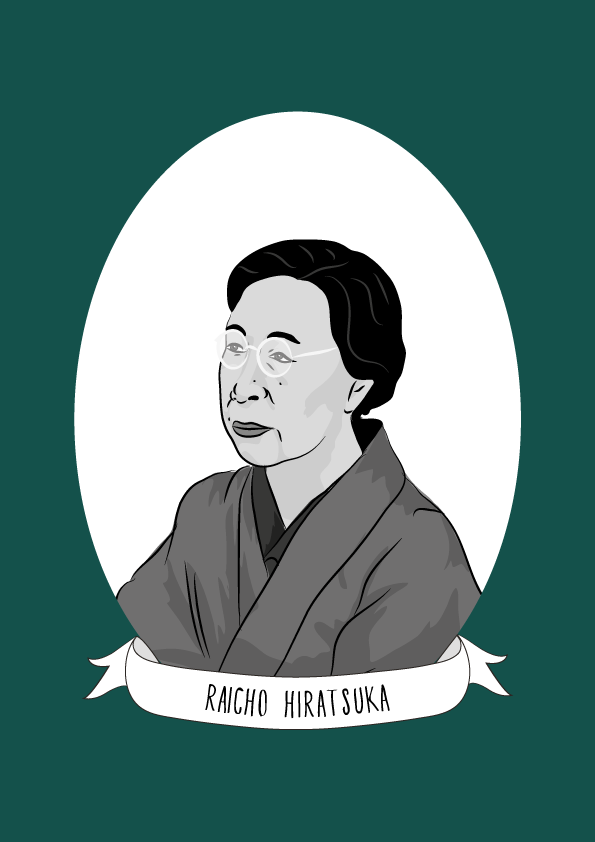Raichō Hiratsuka was a writer, journalist, political activist, anarchist and pioneering Japanese feminist who founded Seitō (Bluestocking) magazine.
Hiratsuka was born in 1886 in Tokyo. She attended Japan Women’s University where she became interested in European philosophy, Zen buddhism and the Swedish feminist writer Ellen Key. After graduating, she continued her education at the Narumi Women’s English School. In 1911, she founded Seitosha (The Bluestocking Society) with some of her fellow graduates who chose the name for the society as a provocative challenge to the male establishment. Hiratsuka hadn’t heard of the word, and researched it to discover their predecessors in Elizabeth Montagu’s literary society, the Bluestockings. Later that year, Hiratsuka launched Seito, Japan’s first all-women literary magazine and adopted the pen name “Raichō”. The first issue sold 1,000 copies and proved that women were capable of successfully producing their own literary journal to rival those by men. Hiratsuka opened the first issue with the words “In the beginning, a woman was the sun”, which was considered as the Declaration of Women’s Rights in Japan.
Seito evolved from a literary journal to become a publication focusing on women’s issues including female sexuality, chastity and abortion and attracted contributors like the renowned poet and women’s rights proponent Yosano Akiko, among others. In addition to this, is introduced western feminist authors to its readership, translating pieces by Olive Schreiner and Ellen Key to encourage Japanese women to develop the feminist consciousness in early modern-day Japan. Hiratsuka had to fight against public opinion, who were influenced by Japan’s mainstream press who were keen to suppress a magazine that they felt was spreading nonconformist ideals. Hiratsuka fought against the press, and in 1913 published an essay entitled “To the Women of the World” which rejected the conventional stereotype of women as simply ryōsai kenbo (良妻賢母, Good wife and wise mother) and contained the words “I wonder how many women have, for the sake of financial security in their lives, entered into loveless marriages to become one man’s lifelong servant and prostitute.” The essay led to the state clamping down magazines which they felt “disturbed public order” or introduced “Western ideas about women” incompatible with Japan.
In 1915, Hiratsuka was well established as a leader in Japan’s women’s movement at the point at which the magazine folded. She turned her attention to lecturing, spreading her call for women to become involved in fighting for their rights and enforcing the fact that women were not born just to serve men.
In 1920, Hiratsuka formed the Shin Fujin Kyokai (New Woman’s Association) together with fellow women’s rights activist Fusae Ichikawa after discovering that female workers in textile factories of Nagoya were being subjected to disgraceful working conditions. The Shin Fujin Kyokai was established to fight for essential rights, including women’s suffrage. Through their campaigning, the group managed to overturn the 1900 ban on women joining political organisations or holding or attending political meetings in 1922. This led to a huge increase in women’s interest groups who grew during World War II. By 1945, Hiratsuka’s fight for women’s suffrage was realised when women were finally granted the right to vote in 1946, partly due to pressure from the occupying forces from the U.S during World War II.
In 1950, Hiratsuka travelled to the U.S. with writer and activist Nogami Yaeko and other members of the Japan’s Women’s Movement to request that Japan could remain neutral and pacifist following the outbreak of the Korean War. Post-war, Hiratsuka devoted herself to fighting for both world peace and women’s rights, serving as the first president of the Federation of Japanese Women’s Societies, the vice-president of Women’s International Democratic Federation and founding the New Japan Women’s Association with Nogami and artist Iwasaki Chihiro. She remained an active participant up until her death, marching against the war in Vietnam and writing and lecturing up until her death in 1971 Her work continues through the New Japan Women’s Organisation .
